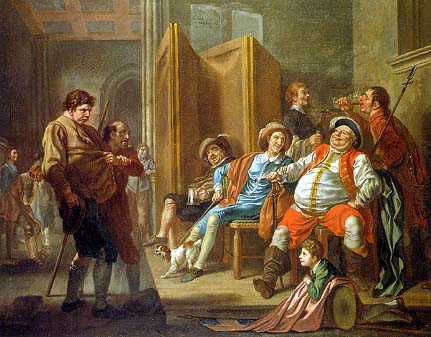
Oil on canvas, approximately 40 x 49 inches. National Gallery of Ireland, Dublin.

Oil on canvas, approximately 40 x 49 inches. National Gallery of Ireland, Dublin.
When rebellion against Henry once more threatens in the north, Falstaff in Act III, Scene ii of Henry IV, Part 2 raises a force of "shadows"--non-existent soldiers for whom the commanding officer receives pay--"to fill up the muster-book." Among the ragged recruits who present themselves for Falstaff's inspection are Mouldy, Shadow, Wart, Feeble and Bullcalf. This shameful scheme of raising a troop of misfits is described more fully in Act IV, Scene ii of Henry IV, Part 1 when Falstaff reflects on the forces he recruits for the Battle of Shrewsbury:
If I be not ashamed of my soldiers, I am a soused gurnet. I have misused the king's press damnably. I have got, in exchange of a hundred and fifty soldiers, three hundred and odd pounds. I press me none but good house-holders, yeoman's sons; inquire me out contracted bachelors, such as had been asked twice on the banns; such a commodity of warm slaves, as had as lieve hear the devil as a drum; such as fear the report of a caliver worse than a struck fowl or a hurt wild-duck. I pressed me none but such toasts-and-butter, with hearts in their bellies no bigger than pins' heads, and they have bought out their services; and now my whole charge consists of ancients, corporals, lieutenants, gentlemen of companies, slaves as ragged as Lazarus in the painted cloth, where the glutton's dogs licked his sores; and such as indeed were never soldiers, but discarded unjust serving-men, younger sons to younger brothers, revolted tapsters and ostlers trade-fallen, the cankers of a calm world and a long peace, ten times more dishonourable ragged than an old faced ancient: and such have I, to fill up the rooms of them that have bought out their services, that you would think that I had a hundred and fifty tattered prodigals lately come from swine-keeping, from eating draff and husks. A mad fellow met me on the way and told me I had unloaded all the gibbets and pressed the dead bodies. No eye hath seen such scarecrows. I'll not march through Coventry with them, that's flat: nay, and the villains march wide betwixt the legs, as if they had gyves on; for indeed I had the most of them out of prison. There's but a shirt and a half in all my company; and the half shirt is two napkins tacked together and thrown over the shoulders like an herald's coat without sleeves; and the shirt, to say the truth, stolen from my host at Saint Alban's, or the red-nose innkeeper of Daventry. But that's all one; they'll find linen enough on every hedge.
The painting, John Christian suggests, is obviously influenced by the theatrical performances of which Hayman was so fond. The background has the look of a stage set and the costumes lack the historical accuracy that was typical of the eighteenth-century theater (166).